According to Human Factors Investigation and Analysis of Accidents and Incidents, human error accounts for between 60–80% of all accidents and incidents.
That statistic has been the cause of many people falsely believing that behavior-based safety (BBS) programs blame the worker. It has also sparked many human and organizational performance (HOP) supporters to believe that BBS and HOP are competing methods for improving safety.
On the contrary, they are complementary methods and both should be integrated into your existing safety management system. It’s important to note that both BBS and HOP look for ways to minimize human error while understanding behavior.
When human error is found to be the cause, there’s a misapprehension that it will be used as grounds to punish the human involved in the error. It’s a classic cause and effect—in the event of an incident, people will always look for who caused it. Blame has become a natural reaction. The problem with blame is that it overshadows the real root of a problem and doesn’t allow it to be addressed properly.
The word ‘error’ has negative connotations, but mistakes can have very positive outcomes. A Framework for Managing Human Factors breaks it down like this:
It is not only the prevention of error that keeps people safe, it is also the proactive, thoughtful actions that people take to do things better and safer.
Furthermore, as cognitive science advances, there is increasing evidence that some of what might previously have been called “human error” would be better ascribed to inherent cognitive habituation that occurs below the level of consciousness. This is an example of a human factor that may need to be addressed in some way, but which is not accurately described as an error.
The term “human factors” is used here with purpose, to broaden the focus to include human performance optimization, and to avoid the pitfall of labeling inherent cognitive processes as errors.
BBS focuses on remaining non-punitive while assessing at-risk behavior, the choices people make to remain safe and how flawed systems factor into an incident. Meanwhile, HOP states that human factors are inevitable and it’s important to look for the error in system failures.
HOP reinforces that blame and punishment are detrimental to safety and BBS upholds that view by looking for the context in which something happens. In order to avoid blame, take a cue from HOP and BBS systems. A root cause analysis should take place to determine what caused the accident instead of focusing on who caused the accident.
Here are three steps to ensure blame is not assigned when it comes to human error.
- Hazard Analysis – A great place to start is to look at the tasks that need to be performed and define potential risks associated with each task. In order to identify all present or anticipated dangers, be sure to consider the state of mind of the employee on site—this is particularly important when determining how human error impacts a system and vice versa. Make this part of your hazard identification checklist to ensure it’s checked every time.
- Training – Human factors specialists train people to recognize the actions (and influences behind them) that led to an incident or accident. Although it may not be possible to predict the next occurrence of human error, people are frequently able to recognize certain states of mind that can lead to an incident. Training supervisors on human factors helps with meaningful communication and recognizing the implications of their work directions while using this knowledge in root cause analysis can help to anticipate problems in the future.
- Ease of Reporting – Confidential near-miss reporting can help to establish control over hazards that could have led to a workplace injury. This is also critical to establish a timeline to determine when and how things could have been worse. No one intends for incidents to happen, and by eliminating the fear of reporting near-miss incidents, more people will be inclined to report, which will make it easier to analyze the threat and improve processes for the future.
The Human Factors Framework establishes how an organization can develop a system within the company to handle workplace operations and safety by learning from established human factors.

Ideally, you’ll have a system of communication that moves up and down from top to bottom in your organization and also laterally across departments. A traditional BBS observation and feedback process wouldn’t make sense if nothing was done to improve conditions following the observation. And HOP leaders can’t be informed without effective input from the people doing the work.
When human factors cause an incident, try to focus on improving the safety management system and implement a human factors training course that will help employees identify how their state of mind can lead to errors. The most important thing about pinpointing human factors is to minimize the impact on future situations not punish the human who made an error—especially since the error is most often predicated by a number of factors, many of which are beyond their control.

